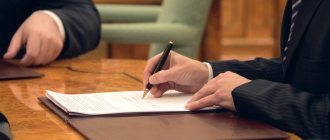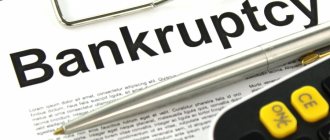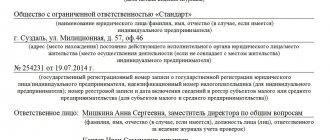Almost everyone faces an unpleasant situation when a debtor is unable to repay borrowed funds. Sometimes the reason for non-payment is financial insolvency, sometimes the reason is reluctance to repay existing debts. If an individual or company evades payments, and the creditor is unable or unwilling to forgive the loan, a law bringing the debtor to subsidiary liability .
According to innovations in Russian legislation, not only business owners with debts can be forced to make payments, but also senior managers, non-ordinary managers, the head of the financial department or an accountant. The main thing is to receive competent legal support in a timely manner, because collecting subsidiary liability is a labor-intensive process and is associated with many tricks (“loopholes” in the law that the debtor will try to find).
So that the petition for bringing to subsidiary liability does not remain a “dead weight” on the table of officials, but brings real results - namely, solving the problem and repaying the debt - it is advisable to seek advice from the lawyers of our company. Cooperation with Intellectual means saving time, money and, of course, saving your nerves.
Our specialists will provide an initial consultation over the phone free of charge - we will answer any questions that may arise and help you develop a competent strategy for the subsidiary liability of the creditor to the debtor. Further visits to lawyers with many years of experience in collecting the necessary documentation and presenting it in court - from 4,000 rubles, depending on the complexity and urgency of the case.
Debt collection under subsidiary liability: where to start
Ideally, subsidiary liability should be assigned to the main debtor - a company or individual who took out a “borrow” and failed to deal with the obligations in a timely manner. However, he may simply not have the means, and in this case, it would seem necessary to “understand and forgive.” And lose money, of course.
The law protecting the rights of creditors provides “escape routes” through which debts can be collected and the debtor held vicariously liable . According to the current civil law scheme, three parties participate in the legal relationship:
- Directly the main debtor is the entity that used borrowed funds according to the agreement or has other debts to the plaintiff
- Creditor - a person or organization that has financial or property claims against ML
- Third parties (additional debtors) who had decision-making power and whose actions allegedly led to bankruptcy and the inability to repay debts
The search should begin with the main thing - to determine the person responsible for non-payments or bankruptcy of the company. Simply put, find someone who can be held vicariously liable . If previously, in the absence of assets in the organization and property subject to seizure, the owners and founders with investments, then according to the amendments to the draft law No. 488-FZ, which came into force in June 2021 and has already proven its worth, the list of financially responsible persons has been expanded.
Today you can bring to subsidiary liability:
- LLC founder
- company owner
- directors
- financial director
- chief accountant
- top managers
- non-ordinary employees who have the right to make important decisions
- persons closely associated with the bankrupt company, including intermediaries
Moreover, if the above-mentioned persons have proven their innocence or financial/property inability to pay debts, a petition for subsidiary liability can be sent to majority shareholders, relatives of management (the practice of registering property in the name of a wife and mother-in-law occurs), counterparties of the bankrupt and even members of the liquidation commission , if there are suspicions that the official decision on bankruptcy is a way to avoid paying off the debt.
Legal presumptions when bringing to subsidiary liability
Legal presumptions when bringing to subsidiary liability
Presumptions play a huge role in distributing the burden of proof and in determining what elements the applicant needs to prove and what the defendant must prove. O.S. Ioffe wrote that “the presumption places on the party the burden of proof of precisely those circumstances that may be known to it in the first place”[1].
The Bankruptcy Law provides for a number of legal presumptions regarding the status of a person controlling the debtor (Article 61.10), bringing to subsidiary liability for the inability to fully repay creditors' claims (Article 61.11), for failure to submit (untimely filing) the debtor's application (Article 61.12)[2 ].
Presumptions facilitate the process of proving by the applicant the circumstances included in the subject of proof on the grounds of bringing to subsidiary liability.
According to the “Letter” of the Federal Tax Service of Russia dated August 16, 2017 N SA-4-18/ [email protected] “On the application by tax authorities of the provisions of Chapter III.2 of the Federal Law dated October 26, 2002 N 127-FZ” all the presumptions provided for in paragraph 2 of the article 61.11 of the Bankruptcy Law are intended to facilitate the proof of one basis for bringing to subsidiary liability, that is, to directly conclude that it was the actions (inaction) of the CDL that resulted in the impossibility of fully repaying the creditors’ claims.
However, these legal presumptions appeared not so long ago. It was extremely difficult for the applicants to prove the entire set of circumstances included in the subject of proof for general civil liability, namely:
- the status of the controlling debtor of the person with the defendant;
- Negative consequences;
- the cause-and-effect relationship of the actions/inactions of the CDL with these consequences;
- the amount of subsidiary liability;
- guilt.
Only Federal Law No. 134-FZ of June 28, 2013 “On amendments to certain legislative acts of the Russian Federation in terms of combating illegal financial transactions” introduced legal presumptions in paragraph 4 of Art. 10 of the Bankruptcy Law in the following wording:
Until proven otherwise, it is assumed that the debtor is declared insolvent (bankrupt) due to the actions and (or) inaction of persons controlling the debtor in the presence of one of the following circumstances:
damage was caused to the creditor's property rights as a result of this person making or in favor of this person or approval by this person one or more transactions of the debtor, including transactions specified in Articles 61.2 and 61.3 of this Federal Law;
accounting and (or) reporting documents , the obligation to maintain (compile) and store which is established by the legislation of the Russian Federation, at the time of issuing a ruling on the introduction of supervision or making a decision to declare the debtor bankrupt are missing or do not contain information about the objects provided for by the legislation of the Russian Federation, the formation of which is mandatory in accordance with the legislation of the Russian Federation, or the specified information is distorted, as a result of which it is significantly difficult to carry out the procedures used in a bankruptcy case, including the formation and sale of the bankruptcy estate.
This version of the law introduced presumptions of a causal connection between the actions of controlling persons and the bankruptcy of the debtor , as well as the guilt of the person controlling the debtor. Consequently, the burden of refuting the existence of causation and guilt began to fall on the person involved.
In previous editions of the Bankruptcy Law, a rule was formulated on bringing to subsidiary liability if the applicant proves the fact of guilt and causation. The percentage of satisfactory decisions was extremely low due to the difficulty of the applicant proving the entire set of circumstances.
The established presumptions are rebuttable, which means the following: when applying to the court with an application to bring the debtor’s manager to subsidiary liability in accordance with paragraph 4 of Article 10 of the Bankruptcy Law, the specified circumstances should not be proven by the bankruptcy trustee/creditor (they are assumed), but they can be refuted relevant evidence and justification by the defendant, that is, the person who is held vicariously liable.
Thus, the Bankruptcy Law clearly indicates that in the event of transactions that cause harm to creditors / failure to transfer documents, the guilt of the controlling person and a causal relationship is presumed.
A similar liability of the controlling debtor of the person was established by the wording of the Federal Law dated July 29, 2017 N 266-FZ (Clause 2 of Article 61.11, Article 61.12 of the Bankruptcy Law).
According to paragraph 19 of the Resolution of the Plenum of the Supreme Court of the Russian Federation dated December 21, 2017 No. 53 “On some issues related to holding persons controlling the debtor liable in bankruptcy”, if the circumstances , constituting the grounds for rebuttable presumptions of bringing to bankruptcy, enshrined in paragraph 2 of Article 61.11 of the Law bankruptcy, it is assumed that it was the actions (inaction) of the controlling person that were the necessary cause of the objective bankruptcy.
The presumption regarding the status of a controlling debtor of a person was introduced only by Federal Law No. 266-FZ of July 29, 2017.
Until July 29, 2017 in Art. 2 of the Bankruptcy Law, the term “person controlling the debtor” was defined, special cases were listed in which members of the liquidation commission, a person who, by virtue of the authority based on a power of attorney, a regulatory legal act, or special authority, could make transactions from on behalf of the debtor, a person who had the right to dispose of fifty or more percent of the voting shares of a joint stock company or more than half of the authorized capital of a limited (additional) liability company, the head of the debtor.
According to paragraph 4 of Art. 61.10 of the Bankruptcy Law as amended on July 29, 2017 , until otherwise is proven, it is assumed that a person was the person controlling the debtor if this person:
1) was the head of the debtor or the debtor’s management organization, a member of the debtor’s executive body, the debtor’s liquidator, or a member of the liquidation commission;
2) had the right, independently or jointly with interested parties to dispose of fifty or more percent of the voting shares of a joint-stock company, or more than half of the authorized capital of a limited (additional) liability company, or more than half of the votes in the general meeting of participants of a legal entity, or had the right to appoint (elect) the head of the debtor;
3) benefited from the illegal or dishonest behavior of the persons specified in paragraph 1 of Article 53.1 of the Civil Code of the Russian Federation.
Refutation of the status of a controlling debtor of a person rests with the defendant in the case.
It is interesting to pay attention to paragraph 2 of the norm, which states that the presumption in relation to limited liability companies applies when owning 50 percent or more. However, in judicial practice, courts apply this presumption to founders with a share equal to 50%.
Legal presumptions were introduced by the legislator to simplify the applicant’s proof of the grounds for bringing him to subsidiary liability. In order to maintain a balance of interests of the parties, the legal presumptions introduced by the legislator are constantly developing and changing.
Regulations:
- Federal Law of October 26, 2002 N 127-FZ (as amended on July 3, 2019) “On Insolvency (Bankruptcy)” (as amended and supplemented, entered into force on July 3, 2019);
- Federal Law of June 28, 2013 N 134-FZ (as amended on July 29, 2017) “On amendments to certain legislative acts of the Russian Federation in terms of combating illegal financial transactions” (as amended and additionally, entered into force on January 28. 2018);
- Federal Law of July 29, 2017 N 266-FZ “On Amendments to the Federal Law “On Insolvency (Bankruptcy)” and the Code of the Russian Federation on Administrative Offences”;
- “Civil Code of the Russian Federation (Part One)” dated November 30, 1994 N 51-FZ (as amended on August 3, 2018, as amended on July 3, 2019) (with amendments and additions, entered into force on June 1, 2019 );
- <Letter> Federal Tax Service of Russia dated August 16, 2017 N SA-4-18/ [email protected] “On the application by tax authorities of the provisions of Chapter III.2 of the Federal Law dated October 26, 2002 N 127-FZ.”
Bibliography:
- Gorbashev I.V. On some substantive and legal aspects of bringing to subsidiary liability in the clarifications of the RF Armed Forces // Bulletin of Civil Law. 2021. N 4. P. 154 – 202;
- Ioffe O.S. Liability under Soviet civil law. L., 1955;
- Pirogova E.S. Criteria for establishing a cause-and-effect relationship as part of the grounds for subsidiary liability of a controlling person for bringing a debtor to bankruptcy // Civil Law. 2017. N 2. P. 33 – 37;
- Pokrovsky S.S. Evolution and problems of legal regulation of civil liability for bankruptcy // Law. 2021. N 7. pp. 40 – 49.
[1] Ioffe O.S. Liability under Soviet civil law. L., 1955.
[2] Federal Law of October 26, 2002 N 127-FZ (as amended on July 3, 2019) “On Insolvency (Bankruptcy)” (as amended and supplemented, entered into force on July 3, 2019);
How to file for subsidiary liability
The procedure for bringing to subsidiary liability an LLC , its founders, director, accountant, counterparty and other persons is regulated by Art. 399 of the Civil Code of the Russian Federation. To “get things moving” you need to:
- Conduct an investigation into the circumstances of bankruptcy (conducted by a bankruptcy trustee appointed by arbitration procedure)
- Officially declare the company bankrupt
- Compile a register of creditors' claims
- If signs of intentional/fictitious bankruptcy are established, provide an expert opinion
- Submit a petition to the court to hold the manager vicariously liable
What follows is the procedure for concluding subsidiary liability and selling the property of persons found guilty of bankruptcy. Debt repayment is calculated from the funds received from the sale of property or the seizure of bankrupt accounts.
The law in this case is on the side of the creditor - there is a presumption of guilt, that is, the defendant is considered guilty until he proves otherwise. However, in today's legislation there are enough points, guided by which the debtor can avoid financial liability or reduce the amount of compensation.
Subsidiary liability of the chief accountant
The chief accountant of a company, if he is guilty of causing damage to creditors, along with the director and founders, can also be held vicariously liable.
Circumstances that indicate the guilt of the chief accountant are listed in subsection. 2 p. 2. 1.11 Federal Law No. 127.
Thus, if accounting documents are missing or do not reflect real information about the company’s property, which should be included in the bankruptcy estate, then the chief accountant will also be recognized as a subsidiary debtor for the company’s obligations.
The legislation describes in detail the situations and circumstances in which the persons managing the company (founders, director and chief accountant) may be found guilty of causing damage to creditors. Consequently, if their guilt is established, the arbitration court has the right to recognize them as fully or partially subsidiary debtors for the outstanding obligations of the bankrupt legal entity.
What is written in the law: how to prove subsidiary liability
In Art. 56 of the Civil Code of the Russian Federation states that a legal entity is responsible for its obligations with all existing assets and property. If the fault of the bankruptcy of the owners, founders or management of the business is established, financial responsibility falls on them. It is possible to assign subsidiary liability to the controlling body, manager or counterparties, who are fully obliged to respond with their property if the company’s assets are not enough to pay creditors.
According to the amendments to the bill, there may be several responsible persons, but in any case, administrative penalties through the court will be imposed if:
- the investigation revealed the lack of necessary documentation or distortions in it
- bankruptcy was recognized as fictitious and the guilt of the owners or senior managers was confirmed
- the procedure for official recognition of bankruptcy was not followed in accordance with the current regulations
Who will be held vicariously liable and when?
The new amendments do not introduce significant changes and only transfer the rules governing the justification of claims for subsdiary liability from the repealed Article 10 to the new Art. 61.11. The wording has essentially remained the same. The first ground is related to damage to the property rights of creditors as a result of the guilty actions of the controlling person. To use this basis, creditors, the managing and authorized body must prove:
- the presence of damage caused to the property rights of creditors, i.e. impossibility of repaying the debtor's debt in full;
- a cause-and-effect relationship between the execution or approval of transactions by the head and (or) founder of the debtor and the fact of causing such harm, with the exception of holding the head of the debtor to subsidiary liability in the absence (failure to provide) accounting documents or distortion of the information contained in them. In this case, it is sufficient to establish the presence of one of the above circumstances and not to prove a cause-and-effect relationship.
In practice, this means that the applicant must provide the court with evidence that it was the actions of the controlling person that led to bankruptcy. In essence, this is not much different from proving the guilt of a specific person.
Thus, in case No. A79-3955/2009, the bankruptcy trustee was faced with the fact that, at the direction of the founders, the bankrupt made a number of unprofitable transactions. The manager went to court to bring the controlling persons to subsidiary liability. However, courts of all levels sided with the founders.
In its ruling dated September 29, 2015 in this case, the Supreme Court substantiated its position with the following arguments:
- “the execution, on the instructions of the defendants, of transactions as a result of which the debtor suffered losses... was not the only and unconditional reason for the debtor’s bankruptcy”;
- almost all transactions were concluded during the period of solvency of the debtor and profitability of its activities;
- the bankruptcy trustee did not provide evidence of concluding transactions for the purpose of non-execution or improper execution;
- The fact that the defendants have the right to give the debtor mandatory instructions in the pre-bankruptcy period does not in itself indicate the existence of grounds for bringing them to subsidiary liability.
Decisions in which the requirements for bringing to subsidiary liability are satisfied contain an indication that the plaintiff has proven the fact of a cause-and-effect relationship between the actions of the controlling person and bankruptcy. The court recognizes as proven the connection between the actions of the controlling persons and the harm caused by the creditor in the event that dishonest actions occur .
Thus, in case No. A16-1209/2013, the bankruptcy trustee stated that, by decision of the manager, the debtor did not take part in the competition for participation in the lease of utility infrastructure facilities. As a result, this led to a drop in revenue. The manager did not provide any evidence of a connection between the drop in income and bankruptcy. However, the court nevertheless held the manager vicariously liable, finding that there were other obviously dishonest and guilty actions of the manager: he simultaneously created another organization with the same name, but without debt, and began to withdraw all profits to it.
Case No. A56-7049/2012 can be cited as an example. The court held the main shareholder (56%) liable. Because of his actions, the debtor entered into a number of transactions after signs of insolvency appeared, so they could not be executed initially.
However, even if a cause-and-effect relationship between bankruptcy and the actions of the controlling person is proven, it will not be held vicariously liable if it proves that it is not to blame for the impossibility of fully repaying the creditors’ claims , including:
- it acted in accordance with the usual conditions of civil transactions, in good faith and reasonably;
- his actions were carried out to prevent his greater damage to the interests of creditors.
“formal” grounds for holding controlling persons to subsidiary liability have remained unchanged
1. Failure by the director to submit the debtor’s application for insolvency (now this is Article 61.12);
2. Violation of the procedure for maintaining and/or storing documents of accounting records and other documents of the debtor, the maintenance of which is provided for by law, or their failure to provide them to the insolvency practitioner (currently - paragraphs 2 and paragraph 4 of paragraph 2 of Article 61.11);
3. More than 50% of the debt is due to criminal, administrative and tax liability (currently - subparagraph 3, paragraph 2, article 61.11).
The process of proving these facts is simpler than justifying the cause-and-effect relationship between the actions of controlling persons and the bankruptcy of the debtor. It is only sufficient to demonstrate the existence of the relevant circumstance to hold the controlling person accountable.
Thus, in case No. A73-684/2016, the court brought the manager to subsidiary liability, since he did not transfer the primary documents, material and other assets of the debtor to the bankruptcy trustee, and did not apply to the court to declare him bankrupt (Resolution of the Arbitration Court of the Far Eastern District dated June 26, 2017 N F03-2144/2017 in case N A73-684/2016). If there is a proven offense and the resulting debt in an amount exceeding 50% of the claims of third-priority creditors, the court will always side with the creditor.
In most cases, we are talking about offenses related to the payment of taxes to the budget. In fact, tax authorities can not only initiate the bankruptcy procedure itself, but have “their own” basis for subsidiary liability. In this case, it is enough for them to present to the court a decision on the collection of the corresponding amounts of tax.
Despite this, applicants on this basis can be not only tax authorities, but also bankruptcy trustees directly, which they actively use - this can significantly improve the level of repayment of the bankrupt’s debts.
The new law adds two additional grounds for holding controlling persons to subsidiary liability:
1) if the controlling person “on the date of initiation of bankruptcy proceedings has not entered the information required to be entered in accordance with federal law or has entered inaccurate information about the legal entity:
- to the unified state register of legal entities on the basis of documents submitted by such legal entity;
- into the Unified Federal Register of Information on the Facts of the Activities of Legal Entities in terms of information, the obligation to enter which is assigned to the legal entity.” This is, for example, information about the amount of net assets, about the pledge of movable property. By providing false information, the head of the company creates an impression of him that is better than it actually is, for which he may pay in the event of bankruptcy.
2) the debtor began to meet the criteria of insolvency not as a result of the actions and (or) inactions of the person controlling the debtor, but after that he committed actions and (or) inactions that significantly worsened the financial situation of the debtor.
Why do you need the help of a lawyer?
It is unlikely that a person appointed as a “freedman” will agree to voluntarily take on debts and part with the property and savings acquired (whether righteous or unrighteous). That is why, before making a demand to hold the debtor vicariously liable, you will need the help of a lawyer who:
- will help you understand the situation, despite the complexity
- will determine which activities of the creditor are within the legal framework and which are a violation of the law (“knocking out” debts, unfortunately, is a common phenomenon and is criminally punishable)
- will help conduct an investigation and identify persons who can be held vicariously liable
- will provide legal support in collecting documentation confirming the rights of the creditor
- will monitor the activities and conclusions of the arbitration commission investigating bankruptcy
- will present the case in court, bringing it to its logical conclusion
The knowledge of an experienced lawyer will help you not only learn how to bring the founder to subsidiary liability, but also how to receive compensation with the least losses. That is why the sooner the creditor contacts a law firm, the faster the investigation will be carried out and results obtained, thereby saving the plaintiff time and money.
What does the process of bringing to vicarious liability look like?
Once a company's bankruptcy proceedings are completed, the creditor has 3 years to file. The period is counted from the moment the creditor learned or should have known about the grounds for filing the application. In this case you need to meet:
- within 3 years from the date when the court declared the company bankrupt, or
- 10 years from the moment the controlling person committed something that became the basis for prosecution.
For controlling persons, a “presumption of guilt” has been established. And now they must prove their sinlessness.
When the court makes a decision to impose subsidiary liability, a writ of execution is issued. On its basis, enforcement proceedings are opened, and the bailiff is looking for money for creditors. Controlling persons pay debts from their own funds. Moreover, even personal bankruptcy will not relieve them of responsibility.
Here is an approximate recruitment algorithm:
- Wait for the bankruptcy case to be initiated or file a petition for bankruptcy of the counterparty yourself.
- Include claims in the register of creditors' claims.
- Assess whether there are grounds to file an application for subsidiary liability.
- If the arbitration manager does not submit an application, submit it yourself or appeal the inaction of the arbitration authority.
- Wait for the court to decide whether there are grounds for prosecution.
- Choose how to pursue collection: during the bankruptcy process, you can collect the debt through the bankruptcy estate or directly by assigning the rights of claim to another creditor. After bankruptcy, you can independently obtain a writ of execution and seek repayment through bailiffs.
Problems of bringing to subsidiary liability
Attempts by the debtor to evade payments are not the only problem that will have to be faced during debt collection. There are a number of legal nuances that allow a person held vicariously liable , including the bankruptcy trustee and the former director/owner, to avoid payments or minimize them.
For example, you can evade debts by providing an expert’s opinion that other prices and conditions were in effect when concluding the transaction. Thus, the court may decide to reduce the amount of material payments, and the creditor will lose part of the investment. Can they be brought to subsidiary liability if the transaction is confirmed to be fictitious or payments are made at reduced prices? They can. But to recognize the fictitiousness, the creditor will need to collect evidence, which is not always possible and, moreover, not free.
An expert’s opinion, confirming the innocence of the financially responsible person, or an assessment of the company by an audit company can also sway the court on the side of the defendant. There are plenty of ways out for the debtor, but the result is the same - without competent legal support, the creditor may be left with nothing, unless he becomes guilty.
The statute of limitations as a problem of bringing to subsidiary liability is also an important factor. The fact is that there are limits that must be met in order to have the right to file a petition. For three years or no more, the creditor has the right to collect the debt; after that, claims are considered “overdue.” Naturally, intentionally delaying the arbitration investigation is a common phenomenon and it is almost impossible to cope with it alone by speeding up the process.
Grounds for bringing to subsidiary liability in bankruptcy
Persons leading or involved in the management of an organization are held accountable if the debtor does not have enough assets to pay off the debts. Based on Ch. III.2, art. 61.11 and 61.12 in case of bankruptcy of legal entities, the manager or other participants of the company are held liable if:
- the deadlines for filing an application for financial insolvency in the presence of objective signs of bankruptcy were violated;
- a meeting of founders and shareholders was not convened to notify about the current situation.
The Federal Law “On Limited Liability Companies” regulates the holding of managers to subsidiary liability if:
- it was discovered that the organization was deliberately driven to bankruptcy - some companies continue to operate despite financial reporting indicators, from which it is clear that the company is incurring losses;
- fictitious bankruptcy was proven - economic crimes with forgery of documents, concealment of assets;
- the value of the assets of the debtor legal entity is inflated.
How can legal help
Our task is to minimize the monetary and time costs of a client who has applied for advice on bringing to vicarious liability. We consider our strengths to be:
- affordable pricing policy - the first consultation is free
- a staff of lawyers with many years of experience in handling cases in court
- the ability to freely monitor the progress of investigations and confirm the honesty or incompetence of members of the arbitration commission
- comprehensive legal support for the entire period from the beginning of consideration to the end of legal proceedings
Our lawyers are always in touch with the client, ready to answer any questions and come to the rescue immediately. To ensure that you get an experienced representative and avoid problems associated with bringing the management of an LLC or other organizations to subsidiary liability.
Call us, we will definitely help
0
0
0
0










